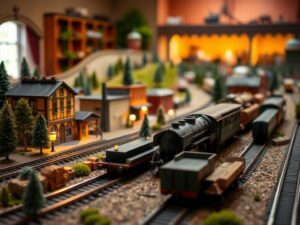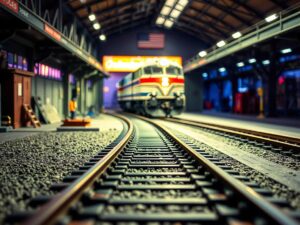Adding Water Features to Your HO Scale Layout
Adding Water Features to Your HO Scale Layout
Adding Water Features to Your HO Scale Layout: Dive into Realistic Aquatic Delights
Hey there fellow rail enthusiasts! Itâs your old pal [Your Blog Name Here], back with another post designed to fuel your model railroading passion. Today, we’re going to explore the magical world of water features in HO scale layouts.
Imagine this: a miniature river meandering through your cityscape, glistening lakes reflecting the sunlight, or maybe even a tranquil pond teeming with lily pads. These watery havens add an undeniable dimension to any HO scale model railway, transforming it from a simple track layout into a breathtaking scene that feels alive and captivating.
Whether you’re a seasoned hobbyist looking for fresh ideas or a budding railroader dipping your toes into this exciting world, let’s dive in together!
Why Add Water? It’s More Than Just Pretty
Beyond their aesthetic appeal, water features serve several practical purposes:
-
Enhancing Realism: Realistic water adds an immersive layer to your layout. The gentle ripples, reflections of bridges and foliage, and even subtle mist create a sense of life that transports you right into the scene.
-
Balancing Your Layout: A large body of water can provide a calming focal point, softening harsh angles and breaks in your scenery, resulting in a more visually appealing layout.
-
Stimulating Creativity: Incorporating water encourages you to think outside the box! You’ll discover exciting new ways to shape terrain, construct bridges and walkways, and even add animated elements like moving gondolas or floating log booms.
Choosing Your Water Wonderland
There are no hard and fast rules when it comes to designing your aquatic feature, but here are some factors to consider:
- Layout Size and Scale: Start small if you’re new to water features. A simple pond nestled behind a building can be more manageable than an elaborate river system. Don’t forget the impact scale has! What looks right on an N scale layout might not translate well to HO scale.
- Regional Setting: Reflect your geographic location. Do you want a gentle lake typical of the Midwest or the turbulent rapids of a mountain stream? The type of water you choose should complement your overall scene.
Bringing Your Water Feature to Life
Now, let’s talk techniques! You have two primary options for creating your HO scale water features:
1. Foam-Based Water:
This classic method involves carving shapes into lightweight foam (commonly pink insulation foam) and then finishing with paint and texture products.
-
Step-by-step Process:
-
Design and Cut: Sketch out your water feature on paper, transfer it to the foam, and carefully carve it with a sharp craft knife or heated wire. Remember to incorporate subtle slopes and variations in depth for a more natural look.
-
Smooth It Out: Fill any gaps and create smooth transitions using additional foam scraps and wood filler.
-
Paint and Seal: Begin with an initial coat of dark blue or black acrylic paint to create the water’s base color. Add layers of lighter blues and greens, blending them softly to simulate depth and variations in light reflection. Top it off with a clear sealer for protection.
-
-
Benefits: Affordability, flexibility, and relative ease of use make this method perfect for beginners.
2. Resin Casting Water:
This technique offers unparalleled realism but requires more skill and specific materials.
-
Step-by-step Process:
-
Create a Mold: You’ll need a waterproof, durable mold to pour your resin into. Options include silicone molds (which can be pricey) or sculpted molds made from plaster or even hardened soap!
-
Mix the Resin: Carefully follow the manufacturerâs instructions for mixing two-part epoxy resin according to the required ratio.
-
Pour and Cure: Gently pour the mixed resin into your mold, ensuring no air bubbles are trapped. Allow ample time for the resin to fully cure according to the manufacturer’s specifications.
-
-
Benefits: Exceptional detail, a wide range of finishes (from flat ripples to glassy surfaces), and durability make resin casting an excellent choice for serious enthusiasts.
Taking it to the Next Level – Enhancing Your Water Feature
Here are some advanced techniques to truly elevate your water feature:
1. Water Effects Medium: These paints or sprays, available at most hobby stores, create shimmering ripples and a reflective surface, adding extra dimension.
2. Animating Flow: Small pumps can be used to gently circulate the water, simulating currents or waterfalls. Be mindful of wiring safety and placement.
3. Reflections and Details: Use decals or even carefully applied real photographs of trees and other foliage around your water feature to create realistic reflections in the water’s surface.
4. Custom Structures: Design and build unique bridges, docks, fishing piers, and boats to further enhance the scene.
Important Notes for HO Scale Water Features
- Maintenance: Regularly clean any debris or algae buildup on your water features.
-
Water Quality (Resin Casting):
If using resin casting, ensure you work in a well-ventilated area and follow safety guidelines provided with the product. Some resins may emit fumes during curing. -
Practice Makes Perfect! Don’t be afraid to experiment! You might not get it perfect on your first try, but with practice, you’ll master the techniques and create breathtaking water features that will wow anyone who sets eyes on them.
So, what are you waiting for? Dive into the world of HO scale water features and transform your railroading hobby into a truly captivating experience!
Feel free to share your water feature ideas or any challenges you face in the comments below. I’m here to help guide you along the way!





